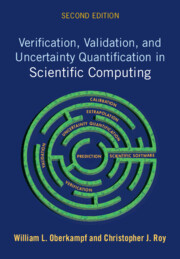Refine search
Actions for selected content:
48581 results in Computer Science
Preface
-
- Book:
- Data, Systems, and Society
- Published online:
- 24 March 2025
- Print publication:
- 27 March 2025, pp ix-xii
-
- Chapter
- Export citation
5 - Complexity versus Relevance
-
- Book:
- Data, Systems, and Society
- Published online:
- 24 March 2025
- Print publication:
- 27 March 2025, pp 73-88
-
- Chapter
- Export citation
1 - Introduction
-
- Book:
- Session Types
- Published online:
- 12 June 2025
- Print publication:
- 27 March 2025, pp 1-6
-
- Chapter
- Export citation
6 - Algorithmic Typing
-
- Book:
- Session Types
- Published online:
- 12 June 2025
- Print publication:
- 27 March 2025, pp 117-140
-
- Chapter
- Export citation
6 - The Care and Feeding of a New Discipline at MIT
-
- Book:
- Data, Systems, and Society
- Published online:
- 24 March 2025
- Print publication:
- 27 March 2025, pp 89-110
-
- Chapter
- Export citation
3 - Infinite Behaviour
-
- Book:
- Session Types
- Published online:
- 12 June 2025
- Print publication:
- 27 March 2025, pp 45-71
-
- Chapter
- Export citation
Index
-
- Book:
- Session Types
- Published online:
- 12 June 2025
- Print publication:
- 27 March 2025, pp 232-234
-
- Chapter
- Export citation
A large language model based data generation framework to improve mild cognitive impairment detection sensitivity
-
- Journal:
- Data & Policy / Volume 7 / 2025
- Published online by Cambridge University Press:
- 26 March 2025, e33
-
- Article
-
- You have access
- Open access
- HTML
- Export citation
Hamiltonicity of sparse pseudorandom graphs
- Part of
-
- Journal:
- Combinatorics, Probability and Computing / Volume 34 / Issue 4 / July 2025
- Published online by Cambridge University Press:
- 25 March 2025, pp. 596-620
-
- Article
-
- You have access
- Open access
- HTML
- Export citation

Data, Systems, and Society
- Harnessing AI for Societal Good
-
- Published online:
- 24 March 2025
- Print publication:
- 27 March 2025
A fuzzy decentralized algorithm for high-rise buildings subjected to seismic excitations
-
- Article
-
- You have access
- Open access
- HTML
- Export citation

Verification, Validation, and Uncertainty Quantification in Scientific Computing
-
- Published online:
- 22 March 2025
- Print publication:
- 03 April 2025
A note on digraph splitting
- Part of
-
- Journal:
- Combinatorics, Probability and Computing / Volume 34 / Issue 4 / July 2025
- Published online by Cambridge University Press:
- 21 March 2025, pp. 559-564
-
- Article
-
- You have access
- Open access
- HTML
- Export citation
Binomial distribution with delay in analysis and parametrization of Ouroboros Praos proof of stake blockchain protocol
-
- Journal:
- Probability in the Engineering and Informational Sciences / Volume 39 / Issue 4 / October 2025
- Published online by Cambridge University Press:
- 20 March 2025, pp. 520-550
-
- Article
-
- You have access
- Open access
- HTML
- Export citation
‘Men must fight, women must wait’: The war in Ukraine and Russian traditionalism
- Part of
-
- Journal:
- Memory, Mind & Media / Volume 4 / 2025
- Published online by Cambridge University Press:
- 20 March 2025, e2
-
- Article
-
- You have access
- Open access
- HTML
- Export citation
WindDragon: automated deep learning for regional wind power forecasting
- Part of
-
- Journal:
- Environmental Data Science / Volume 4 / 2025
- Published online by Cambridge University Press:
- 19 March 2025, e19
-
- Article
-
- You have access
- Open access
- HTML
- Export citation

Polygraphs: From Rewriting to Higher Categories
-
- Published online:
- 18 March 2025
- Print publication:
- 03 April 2025
Comparing classroom and digital settings: the role of basic psychological needs on EFL students’ IDLE engagement
-
- Article
-
- You have access
- Open access
- HTML
- Export citation
A scoping review on lower limb exoskeleton actuation’s description and characteristics
-
- Article
-
- You have access
- Open access
- HTML
- Export citation
























